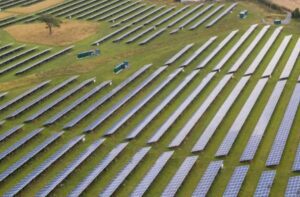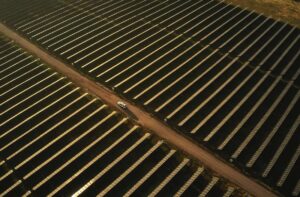Further detail has been released on the proposed development of a “baseload” solar thermal and storage power plant in Port Augusta, South Australia, using Australian made technology owned by NSW-based company Solastor.
The ambitious 170MW, $1.2 billion project was officially launched in Adelaide on Tuesday by Solastor’s high profile chairman, John Hewson, who said he was confident the technology could produce the lowest-price 24/7 solar power in the world.
And according to Solastor, this low cost of the technology, along with its “dispatchability”, makes it “the ideal technology” to replace the almost 20,000 megawatts of coal-fired power plants “that will inevitably be phased out over the next 10 to 20 years,” as well as diesel generation systems such as those used in remote communities, islands and mine sites.
In Australia alone, the company says, there could be a market for 400 Solastor plants.

Hewson – an economist and one-time leader of the federal Liberal Party who advises the current Coalition government on climate change and the low-carbon economy – says the proposed Port Augusta plant will be funded mostly by private investors (he has also suggested that one bank has offered to fund “the lot”) with possible added support from the Clean Energy Finance Corporation and ARENA.
“Basically, we don’t see that there will be any difficulty financing it,” Hewson said in interviews on Tuesday.
“This is world-class. We think this is something we can roll out not only across Australia but internationally. It’s Australian technology, it gives Australia a real edge … in actually being able to turn sunlight into effective baseload energy,” he said.
“We’re going to break (the Port Augusta project) into two stages: 50MW in the winter and 80MW in the summer is stage one, then repeat it stage two. So that’s $530 million to raise in the first stage and we’re pretty confident that we’re well-advanced in terms of that financing.”
Hewson said the plant, which would have a capacity of 110MW in winter and 170MW in summer, would use technology that had been proven in China, at a small pilot plant built in the Jiangsu province (pictured below).

The main advantage of the Solastaor system, he argues, is its storage capabilities, which allow it to provide 24/7, “dispatchable” clean energy – a feature of all solar thermal technology that makes it a favourite technology for 100 per cent renewable scenarios.
But unlike many other solar thermal technologies, which use molten salt for storage, Solastor uses a “high purity” block of graphite – 10 tonnes per storage tank, per 24 metre tower – which can be heated to a maximum of 800°C and store “effective energy” for up to a week, according to the company, depending on thermal losses and the energy draw-down rate of the system.

In an extensive Q&A on the project and technology released by Solastor at the launch, the company appears to suggest that its graphite storage systems are safer that their molten salt counterparts, which it associates with bird deaths and fires. (Giles Parkinson examines this and other possibly questionable claims in his feature article today, here.)
In terms of bird deaths, this is likely a reference to the US Crescent Dunes CSP tower plant which, as was reported here last year, caused the death of 115 birds during testing of the heliostats in standby position, when they are not aimed at the tower receiver but somewhere in the air. The problem – basically, the “halo” of intense sun rays reflected by 3,000 heliostats killed the birds as they flew through it – was, however, promptly resolved by SolarReserve engineers.
Solastor says this is unlikely to happen with its technology, which is modular – so rather than pointing thousands of heliostats at one central tower, clusters 86 sun-tracking heliostats around each tower (as you can see in the Chinese example pictured above). It will have 1700 such towers in a facility of the size proposed for Port Augusta.
Another claimed advantage of the modular design, according to Solastor, is that plants can be constructed on uneven terrain, making their location more flexible.

The company says it is aims to build a five-tower, 1MW demonstration plant by the end of this year, which it would connect to the grid via the existing connection at Port Augusta.
And if it succeeds, and expands the plant to a 170MW facility, Solastor says it would be able to power more than 200,000 homes and fill the gap left when the last of South Australia’s coal-fired power stations shut down in Port Augusta last month.
“Solar thermal heat storage and power generation is more cost-effective than solar photovoltaic or wind energy, which require expensive electric battery support to provide uniform power delivery,” Hewson said at the launch on Tuesday.
According to Solastor’s calculations, the price for power from one of its power stations will be approximately 12c/kWh, including generation and storage, which will then fall to 6c/kWh once financing costs are paid and then 4c/kWh in the second half of the facility’s 50-year life.
“We can produce the lowest price 24/7 solar power in the world and we’re confident of that,” Hewson told Indaily.com.

Hewson also argues that solar thermal generation is cleaner than existing solar PV and wind generation, which he says “often require fossil fuelled generation support to level out intermittent power delivery to the grid.
“With this new facility, South Australia will be able to increase its renewable energy capacity and reduce its dependence on power imports from Victoria, after having lost approximately 25 per cent of its baseload power supply due to the recent closure of the Port Augusta coal fired power station,” Hewson said at the launch.
Meanwhile, Solastor is working to generate bi-partisan support “at all levels of government” for the project – federal environment minister Greg Hunt was front and centre at the launch, as was his Labor counterpart Mark Butler and representatives of the SA government – as well as support from the local community.
The latter may be more difficult than it sounds, considering the proposed 110MW-170MW plant would include 1,700 24 metre tower modules.
According to the aforementioned Q&A, each module occupies a footprint of 2,400m2, and with allowances for access, the power station and associated facilities, would amount to approximately 4 modules per hectare.
A “typical” large-scale Solastor power station capable of providing 50MW in winter and 80MW in summer – so half the size of the plant proposed for Port Augusta – would be made up of 780 modules and occupy approximately 200 hectares.








